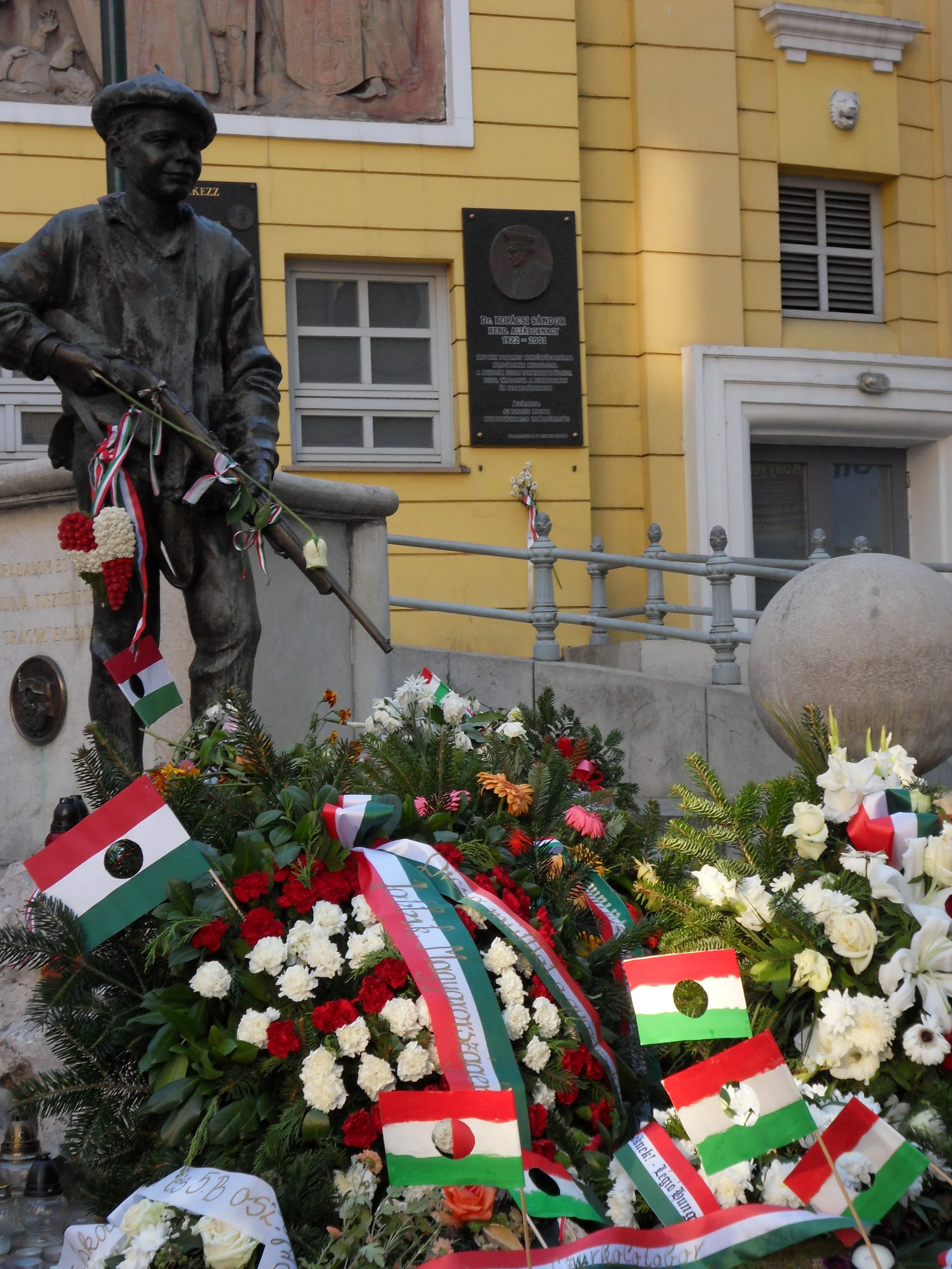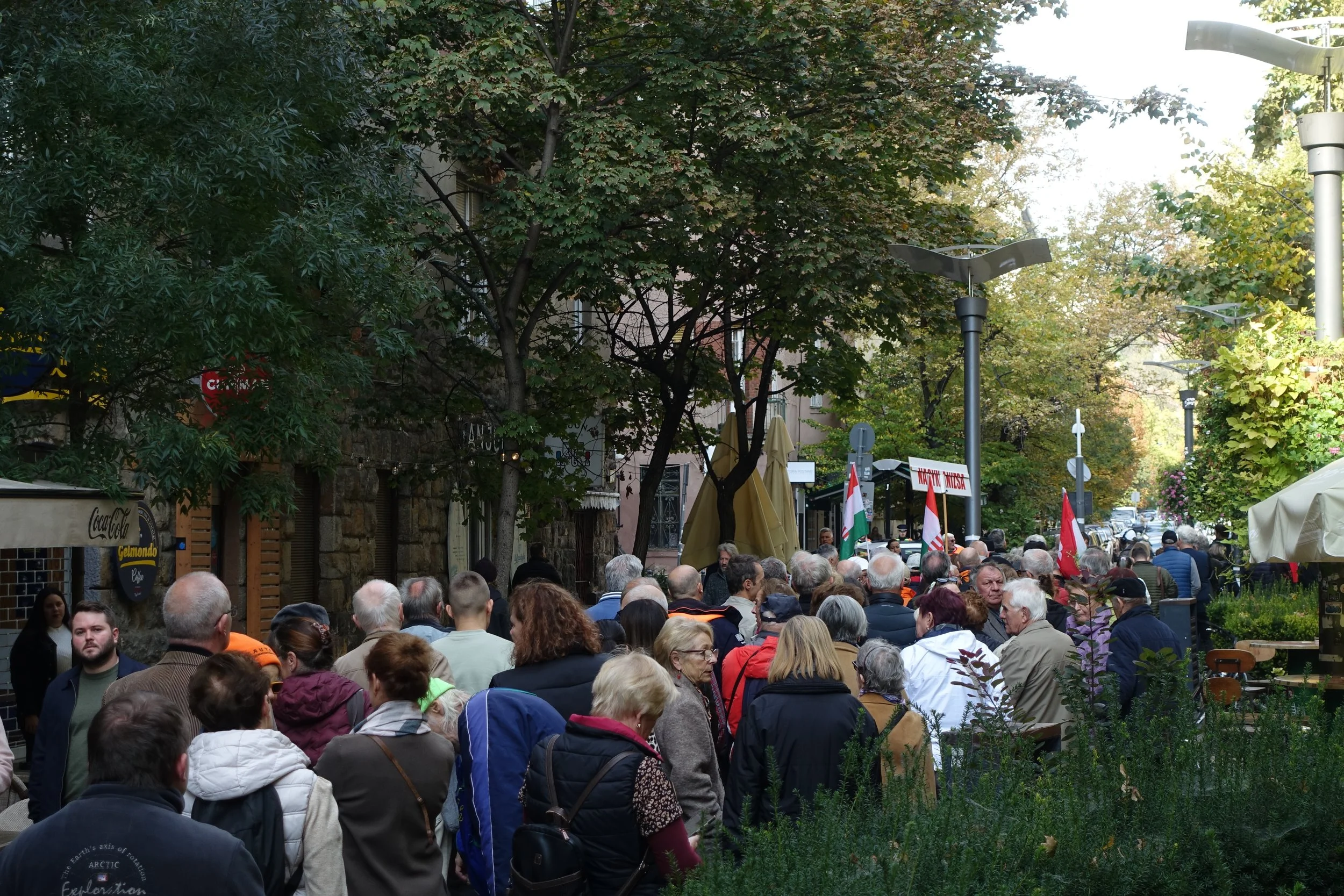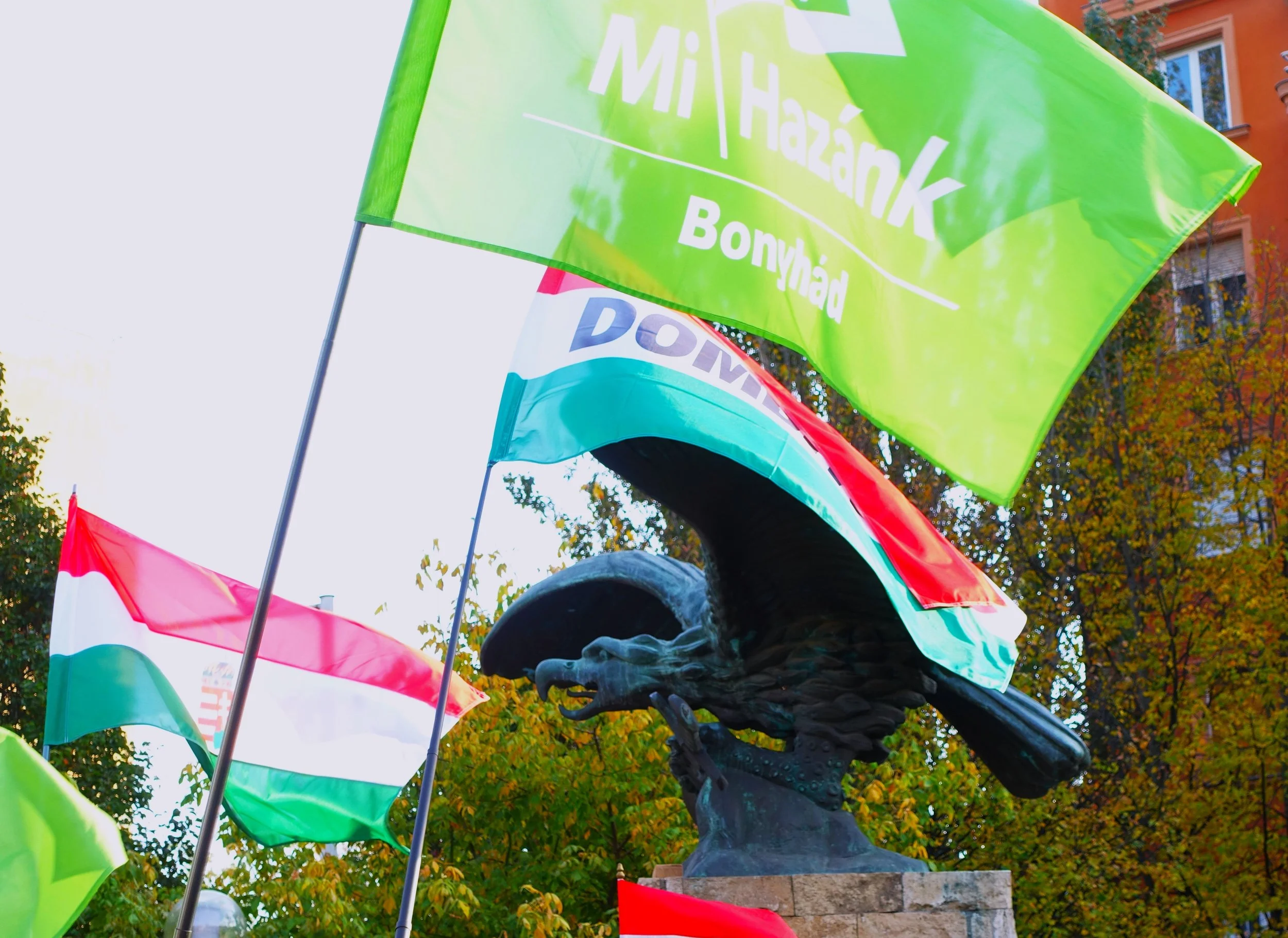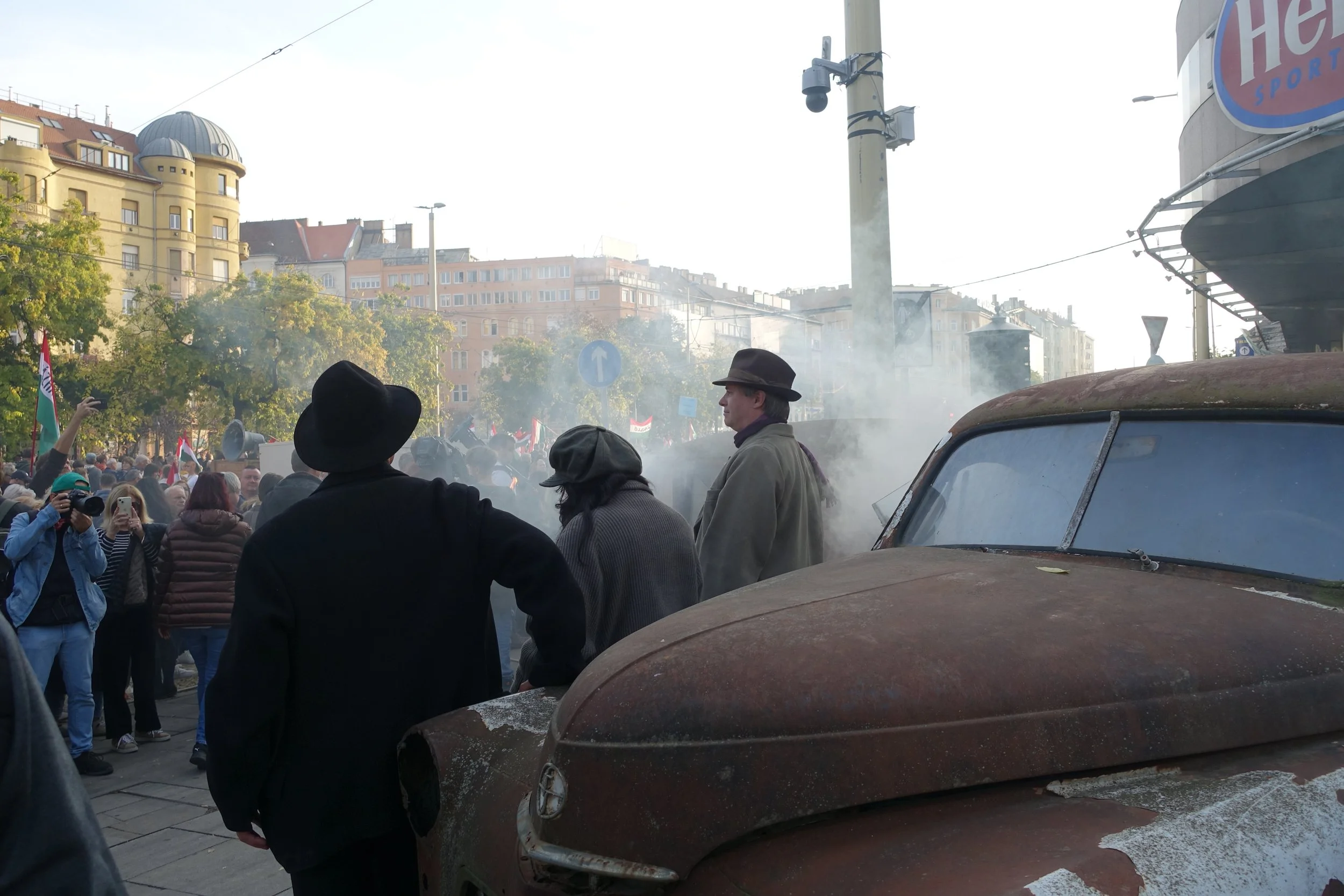Three rallies
The police overtime bill in Budapest on October 23rd must have been high. As Hungary celebrated and commiserated the anniversary of the 1956 uprising against the Soviet Union, three political parties of the right chose to tap into feelings of national solidarity by holding rallies. Normally it rains on the public holiday, and the weather takes on a sombre mood fitting for the ultimately failed challenge against the occupying power. This year offered beautiful autumnal conditions, perfect for politicians to gather the faithful and draw others to the cause. The three rallies were held within a twenty-minute walk of a Lutonian Abroad’s address and it provided an opportunity for him to see Hungarian politics in action, as well as enjoy the sunshine.
Symbols of 1956- a Corvin streetfighter and Hungarian flags with Soviet hammer and sickle removed from the centres.
An extremist plot against the life of Viktor Orbán, planned for his public appearance on the 23rd, was foiled earlier in the week by government special services with arrests ensuing. So it was not a surprise that security was tightest at the Fidesz rally. Millenáris park was created from the grounds of the former Ganz, train manufacturing plant. It’s a large site flanked by office buildings, on which government snipers were visible on Wednesday morning. The area in front of the stage was reserved for Orbán‘s ‘base’: Fidesz party supporters bussed in from the provinces and led towards the best viewing points. The rest of us were directed along the sides of the park. Orbán spoke to a sizable crowd waving national flags.
Viktor Orbán’s base bussed in from the provinces
The majority of the Prime Minister’s base appeared to be middle-aged and older people arriving with a spring in their steps. The mood was cheerful and relaxed as though they had made this kind of pilgrimage before. The twenty third of October is about recalling the nation’s battle for freedom and there was an absence of Fidesz party paraphernalia on display. This date offers an annual opportunity to remember that twelve-day period, when an attempt to reform politics from within the Communist Party, morphed into a nationalistic, working-class uprising. The youths of inner Budapest fought with such fury and ingenuity that they initially prevented the Soviet forces combining into an effective fighting force. For about a week it looked as though they had been successful in defeating the occupying troops. Moscow reacted fiercely, sending reinforcements across the border, crushing the uprising in a brutal fashion.
On a peaceful autumn morning it was hard to imagine the fierce fighting that took place at Széna tér, only five-minute’s walk away. I had only seen Orbán once before, inside a limousine within a police cavalcade rushing through the city. Now he looked small and vulnerable on a platform between two large video screens but spoke defiantly, knowing how to raise the crowd with a tirade against Brussels and western warmongers who want to prolong the Ukraine conflict. In 1989 at the reburial of the ‘good communist’ of ‘56- Imre Nagy, Orbán first came to the world’s attention as a fervent young liberal, when he told the Russians ‘Go home’. The well-known British historian, Timothy Garton Ash, who witnessed the velvet revolution- was in Budapest recently promoting his new book- Homelands. He said that Orbán had stood out in the late 1980’s as the most promising young politician from central/eastern Europe. Little did he guess the allegiances Orbán would form since those times.
Certainly, there was no mention of ‘Russians go home’ in Millenáris Park. Recent ambiguous comments by a member of his government appeared to suggest, that in hindsight, the Hungarian people’s revolt against Soviet control in 1956 was unwise. This has caused huge controversy and the politician concerned apologised afterwards. In his speech on this fine sunny morning, Orbán repeatedly said that the threat to Hungary comes from the EU in Brussels and he wants to see a peaceful end to the war in Ukraine. Opinion polls suggest that about half of his party’s supporters believe the West, particularly America, provoked Russia into the invasion of Ukraine in 2022.
Fidesz rally Millenáris Park
After a quick sandwich, I proceeded to my second rally of the day. Loudspeakers blared out around the Buda valleys and a helicopter monitored proceedings from above. Mi Hazánk (Our Homeland) is a small but growing right-wing party led by László Toroczkai, which did better than expected in the European Parliamentary elections in May. While all of the conservative parties in Hungary pride themselves on their nationalism, this movement is the most nativist. Normally they hold rallies on 23rd Oct in the Corvin quarter where some of the most determined resistance to Soviet forces took place in ‘56. This year the scene of their gathering was a small park in the twelfth district, where the statue of a Turul bird installed in 2005 is causing controversy. The Turul is a pre-Christian fertility symbol and there are about 195 statues to be found across the country, including one looking out from the Castle district in Budapest. During the 1930’s, it was adopted as a symbol by the Hungarian Nazi Arrow Cross Party. The 2005 statue was erected in memory of local victims of the Second World War with a memorial plate containing the names. Regrettably, the listing included people who were subsequently identified as Arrow Cross members, who had committed Jewish atrocities nearby in the winter of 1945. The offending names were removed by the local authority, but the controversy continues as district twelve is now governed by the absurdist Two Tail Dog Party, which is considering whether to remove the Turul statue completely.
Mi Hazánk rally with Turul statue
Along with Mi Hazánk flags, those of other right-wing factions could be seen- fellow travellers in their defence of the Hungarian nation. At one point a canon was fired, a blank I assume. There were more men than women present. One speaker quoted the famous poet, József Attila: ‘Nem! Nem! Soha!’ ( No! No! Never!) with reference to the Trianon settlement of 1920 and the overall sentiment in the air was one of perceived treachery. Including betrayal by those political parties who have neglected Hungary’s territorial claims dating back to Trianon. Of betrayal in ’56, when powerful western nations failed to support the revolution in Hungary. Contemporary betrayal from Brussels who would impose migrants and rules that do not suit the Hungarian wishes or nature. The atmosphere was definitely the tensest and most edgy of the three events I attended, but I suspect Mi Hazánk and their ilk will remain a minority attraction in modern day Hungary. The larger right-wing parties are already nationalistic enough to satisfy most people of this persuasion.
I headed down the hill to where I could hear music playing and the crackly sound of distant speeches. My final rally was organised by centre-right Tisza (Respect and Freedom party). The name comes from the country’s longest river, rising in hilly Transcarpathia in modern day Ukraine but previously part of Hungary for long periods of her history. Tisza remained an insignificant grouping until this year, when it provided a home for Péter Magyar, a former Fidesz insider who left Orbán’s party as a children’s home scandal erupted in the spring. His former wife, Judit Varga, resigned as Minister for Justice along with the female President of the state and a Reform church bishop then President of the Synod. Magyar claimed that these were the fall guys, with corrupt practices at the heart of Fidesz left unaddressed. Within a couple of months, Magyar headed up the Tisza party which has surged in popularity at the opinion polls. In the May ‘24 European Union parliamentary elections, Tisza won seven seats. Commentators suggest it represents the biggest threat Viktor Orbán has faced since becoming Prime Minister fourteen years ago.
As I made my way towards the rally, I was distracted by the sound of loud heavy metal music in Millenáris Park. A band of aged musicians blasted out to a small crowd from the same stage Orbán occupied that morning. They were named Ismerős Arcok, which translates as ‘familiar faces.’ Nearby, various government managed organisations held a public service’s open day of sorts. Khaki clad soldiers enabled groups of children to play war games with plastic bazookas. Rifles and submachine guns from the past and present could be held and examined. Modern and ancient ambulances and fire engines were available for inspection. Outside the ‘Disaster Management’ tent, an AI fuelled robot played with the kids, twisting into various animal shapes and jumping like a rabbit. At the police stand the audience could play with batons and face shields next to mannequins dressed in riot control uniforms. It was a militaristic and well organised event but somewhat devoid of the youthful audience who might enjoy such activities, become interested in a uniformed career, or just be persuaded that there are new enemies at the gate. Not from the east this time but from migration loving Wokery in the EU. One sensed that those young adults genuinely interested in politics, were outside of the park listening to Péter Magyar. I saw buses waiting to transport Viktor’s middle-aged base back to the countryside. They looked happy and content after enjoying a good day in the capital, ignoring the mounting crowds two hundred metres away.
Tisza party rally in Margaret Boulevard evoking memories of 1956
Tisza had organised an afternoon march from near the Danube to Széna tér. Along Margit körút they positioned burnt out trams and endlessly smoking vehicles as strange memento mori to the failed revolution. Some serious money had been spent on their day’s proceedings. Dusk was approaching when Magyar spoke from a raised platform. The crowd below him and down the boulevard looked like the largest of the day. It was also the most mixed in terms of age and gender. Tisza offer a centre-right alternative to Fidesz that is willing to work with Brussels and is against Putin’s invasion of Ukraine. In terms of domestic policy there may not be many differences with the present government. Their most distinctive feature is that they are not Fidesz and Peter Magyar’s, is that he is not Viktor Orbán.
Although the event ended with bright lights and confetti fluttering, this wasn’t a victory rally and not everyone was cheering loudly at Magyar’s speech. Young faces who have only known a Hungary led by Orbán may have listened with curiosity, rather than with the conviction that he is the answer. But it was by far the most populated and dynamic event I witnessed that day. Magyar’s speech focused on the failings of Fidesz, including the perceived betrayal inherent in Orbán’s lieutenant’s unfortunate comments about ‘56. Tisza was tapping into the sentiment of the day and may well capture the more liberal, less nativist conservatives of the capital. If Tisza can draw votes from the centre and left across the whole country, Viktor has got a serious battle on his hands in the 2026 general election. An opinion poll on the following day put Tisza neck and neck with Orbán’s party. As of November this year, they are now edging ahead of Fidesz. The well established left-leaning party in Hungary, the Demokratikus Koalíció-is currently polling at 4 %. The same as the Two Tailed Dog party.
Smoke in the air before Péter Magyar spoke at Széna tér
As I made my way homewards on a mild October evening I reflected on my experience. The excessively loud ‘Familiar Faces’ band had failed to draw crowds away from the opposition rally or drown out Magyar’s speech. Instead, there were hints in the smoky air that we could be entering the autumn of Viktor Orbán’s premiership. The longest serving, current leader of an EU country is a political fighter extraordinaire, but sometimes people tire of familiar faces. A pretender to the throne has come from within. Péter Magyar will hope to be deemed as the country’s salvation at the next election. To have become familiar to voters but still regarded as fresh faced with new ideas. Eighteen months is a long time in politics.
Additional information about the rallies gleaned from:
Telex.hu
Hungarytoday.hu





